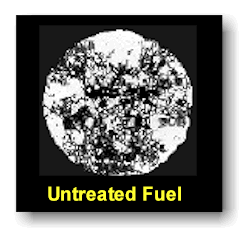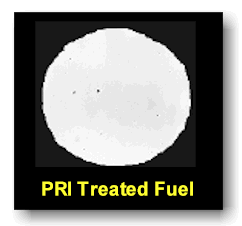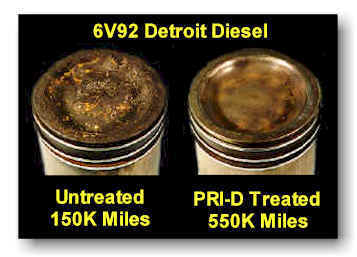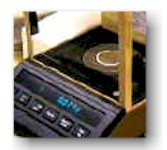
Since fuel is an organic material, it begins to age and deteriorate the minute it leaves the refinery. By the time you put "fresh" fuel in your tank, it has already aged considerably. Fuel continues to age as it sits in your tank, but worse yet, this aging process is accelerated during combustion.
![]()
 Some
things age gracefully, but fuel doesn't. During the aging process, masses of
carbon, gum, and resin form in your fuel. These masses become too large to burn
completely, and the combustion process is compromised. The photograph at right
shows a "fresh" fuel just prior to combustion. Notice the dark areas, where such
masses have formed in the fuel. These masses will not combust completely.
Some
things age gracefully, but fuel doesn't. During the aging process, masses of
carbon, gum, and resin form in your fuel. These masses become too large to burn
completely, and the combustion process is compromised. The photograph at right
shows a "fresh" fuel just prior to combustion. Notice the dark areas, where such
masses have formed in the fuel. These masses will not combust completely.
So what is the result of this aging process and incomplete combustion? Your engine does not perform as designed. Fuel burns less efficiently. Energy and power are lost. Fuel efficiency is reduced. The unburned matter forms abrasive, damaging deposits on your engine and fuel system. In the end, your engine delivers less and wears out faster.

To solve this aging problem, we look at why fuels age in the first place. Fuels age because they become "chemically unstable". During transportation, storage and use, fuels are exposed to oxygen and heat. This exposure causes the atoms in the fuel lose their balance (i.e. become unstable), molecular reactions take place, and the aging process begins. This happens to all fuels, even today's reformulated "clean" fuels.
The good news is, this aging process can be halted and even reversed. If the fuel is kept in balance - kept "chemically stable" - then aging does not occur. This is exactly what PRI Fuel Treatments do! This is why PRI Fuel Treatments are referred to as "fuel stabilizers".

 PRIís
unique, stability enhancing chemistry reacts with your fuel immediately upon
contact. It works chemically within the fuel to keep it at peak stability during
combustion and throughout storage. With the aging process halted, the masses of
carbon, gum and resins do not form. Your stabilized fuel performs better, and
therefore, so does your engine.
PRIís
unique, stability enhancing chemistry reacts with your fuel immediately upon
contact. It works chemically within the fuel to keep it at peak stability during
combustion and throughout storage. With the aging process halted, the masses of
carbon, gum and resins do not form. Your stabilized fuel performs better, and
therefore, so does your engine.
This second photograph shows the same fuel as above, only this time it has been treated with PRI stabilization chemistry. Notice how the fuel is now free from the agglomerations of carbon, gums, resins, and other unburnable matter. Stabilizing the fuel has made a dramatic difference: this fuel will burn cleaner and more completely.
By treating each and every tank of fuel with PRIís stability enhancing chemistry, you will enjoy multiple benefits:
| More power from your engine as your fuel is combusted more completely | |
| Increased fuel economy as fuel is being used more efficiently | |
| A cleaner engine and fuel system as deposits are prevented from forming | |
| Reduced maintenance costs as a cleaner engine runs better and longer | |
| Extended engine life as componentsí life spans are extended |

Why not just use a traditional fuel additive? We have found that enhancing stability is the best way to get the most out of your fuel. Traditional fuel additives seek to improve combustion, but they do it by changing your fuel, boosting cetane or octane, or adding foreign ingredients. This approach can cause an engine to run differently than it was designed to (e.g. hotter) and can even cause long-term engine damage. Enhancing stability gets the job done safely, without altering your fuel or your engine. Furthermore, stability enhancement provides its benefits during storage too, something traditional combustion improving additives do not do.
|
PRI Protects Your Engine |

Here are pistons from two Detroit Diesel 6V92 engines. The piston on the left ran with untreated fuel for 150,000 miles, and is fouled with hard carbon deposits. The piston on the right used PRI treated fuel and has run for more than 550,000 miles! Notice the clean crown and rings, free of carbon build up.

 Fuel
stability tests prove the benefits of PRIís unique stabilization chemistry. Fuel
is heated for 16 hours and then run through a filter. If agglomerations of
carbon and other matter form, then they are captured in the filter and measured.
An unstable fuel will produce a large amount of matter in the filter, whereas, a
stable fuel, which combusts more completely, will produce much less matter.
Fuel
stability tests prove the benefits of PRIís unique stabilization chemistry. Fuel
is heated for 16 hours and then run through a filter. If agglomerations of
carbon and other matter form, then they are captured in the filter and measured.
An unstable fuel will produce a large amount of matter in the filter, whereas, a
stable fuel, which combusts more completely, will produce much less matter.
Independent, unbiased third-party laboratory tests confirm that PRI-D is unmatched in maximizing stability for all fuels, even when compared to competitors. Don't simply rely on hype and misinformation when making your additive choice. Instead, review the independently gathered data and judge for yourself. Better yet, if your company is considering an additive program, we strongly suggest you select a qualified, independent third-party laboratory and conduct your own testing.